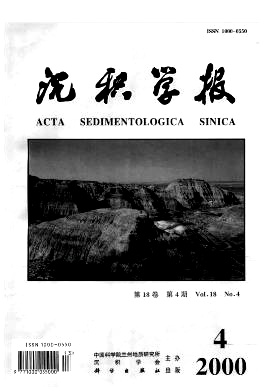Tectonic Units and Sedimentary Signatures in the Chuxiong Foreland Basin System,Yunnan Province[J]. Acta Sedimentologica Sinica, 2000, 18(4): 573-579,610.
| Citation:
|
Tectonic Units and Sedimentary Signatures in the Chuxiong Foreland Basin System,Yunnan Province[J]. Acta Sedimentologica Sinica, 2000, 18(4): 573-579,610.
|
Tectonic Units and Sedimentary Signatures in the Chuxiong Foreland Basin System,Yunnan Province
- Received Date: 1999-07-13
- Rev Recd Date:
1999-10-09
- Publish Date:
2000-08-10
-
Abstract
The Chuxiong Basin in centeral Yunnan is a Mesozoic oil-bearing peripheral foreland basin, which was developed mainly during the Late Triassic, and passed gradually into an intracontinental downwarped basin during Jurassic period. The integration of geological and geophysical data shows that the basin is separated by the YupaojiangShaqiao fault into two parts. According to the classic models, the Triassic sediments in the western thrust zone are generally interpreted as the foredeep sediments, while the eastern part is believed to be a foreland bulge and an intracontinental depression. However, the authors in the present paper argued, on the basis of structure and texture, distribution,stacking pattern and provenance in combination with the geochemical and geophysical data, that the Triassic sediments in the western thrust zone should be assigned to the wedge-top sediments. whereas the foreland area in the eastern part recorded progressive deposition in the foreland basin system. The earlier foredeep sediments might have been consumed under the nappe zone in the west rather than cropped out on the surface. (1)Viewed from the horizontal distribution of sedimentary facies, although the strata in the western thrust zone have undergone multiple phases of tectonic deformation, the earlier Triassic sediments are still well preserved. On the other hand, relatively weak tectonic deformation of the strata in the foreland area in the east once ocurred, and the early strata were apparently consumed under the thrust zone in the west. (2)The stacking patterns of the sediments indicate that the Middle and Lower Triassic strata in the basin should be ascribed to the typical passive continental marginal sediments, which are overlain unconformably by the Carnian or Norian(Upper Triassic)strata with a depositional break during the Ladinian-Carnian, implying that the Chuxiong foreland basin might originate during the early Carnian. Before this period, the whole basin was once in the passive continental marginal area, where stable carbonate deposits prevailed. (3)The Upper Triassic strata may be divided into four second-order sequences altogether four for the wedge-top sediments in the west,three for the eastern part,and one or two for the margins of the basin. The isochronous surfaces in individual sequences can be regionally correlated. (4)The evidences from structure and texture,composition, palaeocurrent direction and geochemical signature have revealed that the Upper Triassic sediments from the wedge-top sediments in the western nappe zone are characterized by low compositional and textural maturity, and progressively thinned sediment thickness toward the western orogenic zone as the source area. The presentday foreland area in the east only accepted the post-Norian deposits with high compositional and textural maturity. The principal source of detritus lay to the Xikang-Yunnan oldland in the east. During the late Late Triassic, the thust zone overthrusted upon the thick rigid lithospheric crust,giving rise to weak warping and slow subsidence of the basin. For this reason, no typical foredeep sediments are observed.
-
References
|
[1]
|
Decelles P G, Giles K A. Foreland base system[J]. Basin Research, 1996, 8:105~123 |
|
[2]
|
Dickinson W R. Plate tectonics and sedimentation [J]. Spec. Publ. SEPM, 1974,22:1 ~27 |
|
[3]
|
Jordan T E. Thrust loads and foreland basin evolution, cretaceous, weastern United states[J]. Bull. Am. Ass. Petrol. Geol., 1981,65:2 506~2 520 |
|
[4]
|
Flemings P B, Jordan T E. Syratigraphic modelling of foreland basin: interpreting thrust deformation and lithospheric eheology [J]. Geology,1990,18:403~434 |
|
[5]
|
Quilan G M,Beatmont C. Applachian thrusting, lithospheric flexture, and the paleozonic stratigraphy of the Eastern interior of north American [J].Can. J. Earth Sci.,1984,21:973~996 |
|
[6]
|
Lyon-Caen H, Molnar P. Gravity anomalies, flexture of the Indian plate, and the structure, support and evolution of the Himalayia and Ganga basin[J]. Tectonics, 1985,4:513~538 |
|
[7]
|
Munoz J A, Casas-sainz A M. The Riojan Trough (N Spain): tecotnosedimen-tatary evolution of a symmetric foreland basin[J]. Basin Research, 1997, 9:65~85 |
|
[8]
|
李勇,曾允孚,伊海生.龙门山前陆盆地沉积及构造演化[M].成都:成都科技队伍出版社,1995 |
|
[9]
|
蒲心纯,尹福光,朱同心.楚雄盆地的充填系列与造山作用[J].岩相古地理,1996,16(3):47~57 |
|
[10]
|
许效松,刘宝珺等.中国西部大型盆地及地球动力学[M].北京:地质出版社,1997 |
|
[11]
|
桂棠,陈智梁等.东特提斯地质构造演化[M].北京:地质出版社,1998 |
|
[12]
|
钟大赉等.滇川西部古特提斯造山带[M].北京:科学出版社。1998 |
|
[13]
|
莫宣学,路风香等.三江特提斯火山作用与成矿[M].北京:地质出版社,1993 |
|
[14]
|
Tapponnier P, et al. The Ailao Shan/Red R. Metamophic belt: turtiary left-laeral sheer between Indochina and S. China [J]. Nature, 1993,343(6257):431 ~ 437 |
|
[15]
|
云南省地质矿产局.云南省区域地质志[M].北京:地质出版社,1990 |
|
[16]
|
Decelles P G, Currie B S. Long-term sediments accumulation in the Middle Jurassic-early Eocene Cordilleran retroarc foreland-basin system [J]. Geology, 1996, 24(7):591~594 |
|
[17]
|
Bhetia M R, Crook K A W. Trace element cheracteristics of greywackes and tectonic setting discrimination of sedimentary basin[J]. Contributions to Mineralogy and Petrology. 1986,92:181~193 |
-
-
Proportional views

-






 DownLoad:
DownLoad: